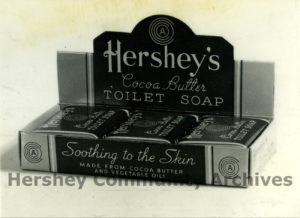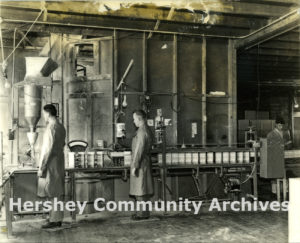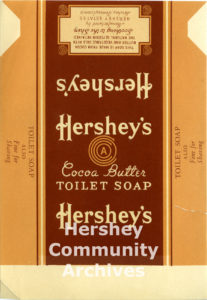Hershey’s Cocoa Butter Soap

Milton Hershey, did not like to have anything go to waste. Around 1936, he decided to make cocoa butter soap as a way of dealing with the million pounds of surplus cocoa butter created by the factory each year. This surplus came from floor scrapings, product and cocoa shells. Hershey Estates was selected to produce the soap since it was a non-food product.
In consulting with his managers, Milton Hershey initially encountered resistance to the idea. He thought he had a ready market for a new product. His managers believed that strong brand loyalty among consumers would create a challenge introducing a new product.
In December 1936, he called Mr. John Hosler, (Manager of the Hershey Department Store from 1928-1955) over to his rooms in the Country Club and gave him instructions. Hershey said he was leaving in a few days for Cuba, and would not be back till the end of March. In the meantime Mr. Hosler was to open a soap plant and have it operating before his return.
“I told him that I knew nothing about soap manufacture,” recalls Mr. Hosler, “but he insisted that as I was the man who sold soap I would know how to make it; and, if I didn’t know, I could learn.”
Hosler began by hiring an eighty year old soap maker and chemist, “Gus” Speicer, who had formerly been employed by the Pennsylvania Soap Company of Lancaster. Machinery was purchased from the Houchine Machine Company of New Jersey. After it was installed in the second floor of the Abattoir Building [today the location of the Hershey Post Office], the new soap department began to manufacture hard-water soap, oatmeal soap, tar soap, pumice soap, and buttermilk soap. But the first attempts to make cocoa butter soap resulted in failure. Seeking additional help, Hosler contacted the DuPont Company in Wilmington, Delaware. With their assistance the challenge of getting the soap to congeal was overcome and soon Hershey was producing two varieties of soap: Hershey’s Cocoa Butter Toilet Soap and Hershey’s Cocoa Butter Rose Garden Toilet Soap. Originally, the cocoa butter content in the bars of soap was 75%.
As soon as he returned from Cuba in the Spring of 1937, Milton Hershey asked for a progress report. He was deeply interested in the project and provided constant encouragement and support in the development of this new product.
Theodore Banks, a chemist, was hired to take over for Gus Speicer. One of the greatest challenges was finding the right perfume to cover the strong natural smell of cocoa butter. Milton Hershey, ever frugal, resisted using any perfume that he felt was too expensive. One day Mr. Hershey had a conference with his board of directors. Banks was asked to bring soaps made with different perfumes to the board meeting.Mr. Hershey took a whiff of each, asking every time, “how much did you pay for that?” One was three dollars, one four dollars, and some were higher. He did not like any of them except one, which cost only $2.91 a pound. When the conference broke up, Milton Hershey called Hershey Estates President Charles Ziegler aside. “You know,” said Mr. Hershey, “I have a cold and I can’t smell anything; but I didn’t want those fellows to get away with that expensive perfume.”
As it turned out, the cheap perfume was not effective, having a poor shelf life. It took weeks of experimenting until they found a successful solution. Again with the help of the Perfume Division of the DuPont Company, Hershey developed a satisfactory bouquet for the regular Hershey Cocoa Butter Toilet Soap and another with a special rose odor for the Rose Garden Toilet Soap.
With production and formula problems solved, Hershey had the soap plant produce a million boxes of cocoa butter soap, filling the warehouse. With an inventory established, Mr. Hosler was directed to sell the product. Initials orders led to repeat business and the soap operation began to expand.
Hershey Estates produced a diverse line of soaps:
1938-1952 Hershey’s Cocoa Butter Toilet Soap
1938-1952 Hershey’s Cocoa Butter Rose Garden Toilet Soap
(marketed only in Hershey)
1938- ? Hershey’s Mechanics Economy Soap
1938- ? Hershey’s Keystone Soap (with pumice added to it
for scouring)
1939- ? Hershey’s Soap Granules
1939-1946 Hershey’s Tar Soap
1941- ? Hershey’s Shaving Soap
Tar Soap was introduced October 1939 to meet the demand for a shampoo soap to compliment Hershey’s Cocoa Butter Toilet Soap. Hershey’s Tar soap was advertised as “an excellent shampoo soap for hair and scalp” selling for 5 cents. In 1941, one consumer wrote “Hershey’s Tar Soap makes the grandest shampoo! It makes the hair feel so clean and soft.”
Initially the soap line was just distributed locally but in 1939 product distribution was expanded to cover a wide territory stretching up to New York City and down to Baltimore and Washington, DC. The sales force grew to 15 men marketing Hershey’s soap to grocery and drug stores.
Soap was a pet project of Milton Hershey’s and he was full of promotional ideas. After the great circus fire in Hartford, Connecticut, he offered hospitals there cocoa butter soap, explaining the curative properties of cocoa butter. He tried to convince the Waldorf Astoria in New York City to place his Rose Garden soap in all the guest rooms, where the address would add prestige to the soap campaign. “At first,” recalls sales manager, Harold Hershey, “the manager was not interested, because we had not guest size but only the regular family size bar. Besides, every national soap company had made the same proposition, just so they could say their soap was used by guests of the Waldorf.” The manager agreed at last, but the experiment was not a success. Hotel guests were apparently puzzled by the chocolate odor which at that time the perfume had not wholly obliterated. “In those days we used to put the soap in a brown wrapper like that of the chocolate bar. We had a complaint from one party who wrote in to say their child had bought some Hershey Soap thinking it was Hershey Chocolate and started to eat it.”
Best remembered of all Milton Hershey’s soap promotion stunts was one that took place in the Sports Arena on a hockey night. George Bartels, Arena manager, told the story in a 1954 oral history interview:
It was Mr. Hershey’s idea to give everyone on a certain hockey night a bar of soap. Before the game, I told some of the officials I thought it would be best not to give it to the people until they were leaving. Otherwise, if anything happened on the ice – if the crowd saw what they thought was a wrong decision by the referee – they might throw the soap.
Mr. Hershey was told about this. He said: “No. I want them to have it when they come in. We might miss somebody going out; and, anyway, nobody is going to throw a cake of soap they got for nothing.”
During the game, the official did make what the crowd thought was a bad decision, and first one cake of soap came sailing through the air, and then it rained soap. Everybody had to duck. Mr. Hershey, when he heard about it next morning, had a big laugh.
Milton Hershey brought his soap to Atlantic City, New Jersey. A store was rented, first near the Ambassador Hotel and afterwards on the Boardwalk near the Steel Pier. In the store window, a tub filled with soap bubbles created by an agitator attracted the attention of passersby. Mr. Hershey used to go to Atlantic City and play about in the store, sitting at the window to watch the people, or taking his place behind the counter, to the considerable anxiety of the regular clerks.
“Madam,” said M.S. one day as he wrapped up some Rose Garden Soap for a customer, “Mr. Hershey will be pleased” – he glanced at the clerks – “very much pleased, when he learns of your purchase.”
The Atlantic City shop continued to operate until 1943 when the seashore hotels were taken over by the government and tourism declined. After the war, the cocoa butter market changed and many new uses were found for what once had been a waste product. Hershey could now sell raw cocoa butter for prices higher than the cost of producing soap. The soap sales force was recalled and soap sales were limited to the local Hershey area.
Hershey Estates stopped manufacturing soap themselves around 1951-1952. After that cocoa butter soap was produced for Hershey Estates by an outside manufacturer. The product formula was altered and the amount of cocoa butter in each bar was reduced to 10%. It was probably at that point when all the other types of Hershey Estates soap were discontinued. Hershey Estates [later HERCO, Inc. and now Hershey Entertainment and Resorts Company] continued to market Cocoa Butter Toilet Soap, primarily in the local region, until 1980. Declining profits resulted in its discontinuation.
About 1987-1988, the company again contracted with a soap manufacturer to produce a cocoa butter soap under the HERCO label. Today it is marketed locally in Hershey-owned retail outlets by Hershey Entertainment and Resorts Company.

